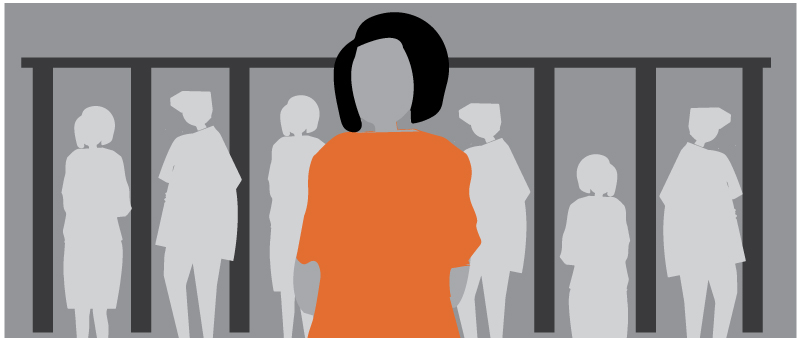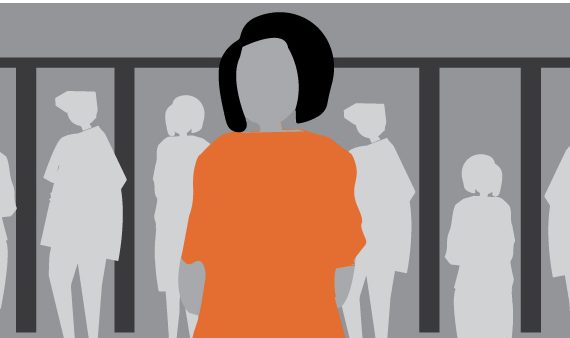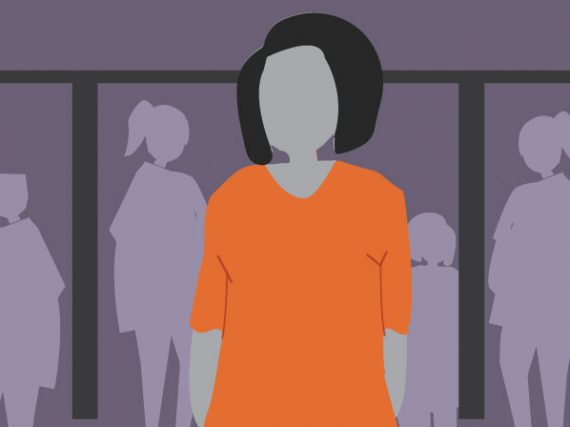COVID-19 and incarcerated women: a call to action in two parts – Part Two
In this two-part series, we draw on our work with partner agencies and people with experiences of imprisonment to argue for women to be prioritised for bail or early release from Victorian jails. This is in advance of a broader CIJ Discussion Paper regarding the imperative for decarceration of women, to be released towards the middle of the year. In the second of this two-part discussion, the CIJ explores the impact on women of measures to manage viral infection in Victoria’s prisons.
Part 2: Incarceration in isolation
At time of writing, there is no evidence of COVID-19 infection reaching Victorian prisons, mirroring the success in the wider community in ‘flattening the curve’.[1] With the easing of social containment increasingly likely, however, so is the risk of a spike in infections.
The government’s response to the risk of COVID-19 entering Victorian prisons has been to introduce prevention and control measures across all prisons, including the Dame Phyllis Frost Centre (DPFC). These measures include:
- the isolation of all prisoners received after 28 March in Protective Quarantine Units (PQUs) for 14 days;
- the suspension of face-to-face personal visits;
- greatly restricted access to services and programs; and
- essential professional visits conducted remotely or from a physical distance.
The CIJ acknowledges the enormous challenges facing governments during this public health crisis and the difficult decisions necessary for prisons to meet their duty of care to inmates and staff. In doing so, however, human rights standards relevant to detention must be maintained.
As outlined in Part 1 of this discussion, the specific vulnerabilities of women in prison require consideration, with care taken to ensure that any changes to daily prison life do not further compound the disproportionately damaging effect of imprisonment on women. The fact that communications relating to the operational changes outlined above are silent on issues of specific relevance to women, is therefore cause for concern.[2]
De facto solitary confinement?
Women in protective quarantine are housed in single-person cells equipped with basic amenities, a television, and a minimum daily ‘check’ by prison staff. Aside from video court appearances, prison emergencies or where deemed necessary by the health team, time out of cells only occurs where ‘operationally possible.’ This means inmates at DPFC are likely to be spending 22 or more hours in a confined space − the threshold associated with the definition of solitary confinement. [3]
To counteract the widely recognised damaging effects of isolation on those in detention, people in protective quarantine have access to increased clinical support,[4] and greater ability to contact family and friends via phone and video. Corrections have also indicated that those quarantined while on remand are informed of the purpose and limited nature of confinement and are offered four days off their sentence for every day spent in quarantine.[5]
While the conditions of quarantine in prison may not seem dissimilar to that experienced in the general community, the isolation of incarcerated people, and particularly incarcerated women, is likely to have a far greater negative impact on physical and psychological wellbeing. With close to double the rate of mental illness of male prisoners, and higher rates of drug use, women are at heightened risk of harm from being detained in isolation. Aboriginal women in prison, 92% of whom have been found to have a lifetime diagnosis of mental illness and close to half suffering from PTSD, are particularly vulnerable. For the estimated 90% of women in prisons who are victim survivors of family violence, being held in a cell for extended periods is also likely to mirror experiences of surveillance and control.
The first weeks in custody are a period of particular vulnerability, especially for those with existing psychosocial conditions and limited social supports. There are additional risks for those with alcohol or other drug dependencies experiencing sudden withdrawal. The recent tragic deaths in custody of two Aboriginal women in Victoria within days of arrest underscores the inherent risks to the health and safety of women in custodial settings.
In recognition of the harm caused by detention in isolation for extended periods, international prison standards, known as the Mandela Rules, stipulate that solitary confinement ‘should be prohibited in the case of prisoners with mental or physical disabilities where their conditions would be exacerbated by such conditions’ (rule 45). The specified period of isolation in a PQU is one day short of what rule 45 defines as ‘prolonged solitary confinement’. In an early literature review on the effects of non-voluntary, solitary confinement, all studies found an association between confinement for longer than 10 days and negative psychological effects on detainees.[6]
The CIJ supports the position of the Human Rights Law Centre (HRLC) that the use of what for many prisoners amounts to solitary confinement, is inappropriate as a means to prevent the spread of COVID-19. Continued access to prisons by the Victorian Ombudsman will be essential to ensure that measures to mitigate the known harms of isolation are implemented as announced.
Social connection
As indicated, with the suspension of all personal visits, women have access to phones as well as video contact via zoom and Skype. While people in prison have no access to the internet, family and friends are now able to communicate via emails sent to the jail. There is no indication from Corrections Victoria communications, however, whether protocols are in place to ensure that women are shielded from family violence when using expanded communication channels.
Agencies still attending DPFC have reported that use of these platforms is dependent on availability of tablets and phones and that women are communicating with loved ones primarily by phone. This can be awkward, particularly where the call is required to be conducted on speaker. On a positive note, some services report that those women who have had remote video contact with children are enjoying the ‘window’ into their children’s lives and home environment that this provides.
Nevertheless, services in contact with clients in jail are particularly concerned that women are finding it difficult to maintain contact with children subject to child protection orders. There is a risk that barriers to communicating with children during this time, sometimes due to delays in the Department or the foster parent facilitating contact, will weaken a woman’s case for family reunification. This is a real issue in matters where the two-year period after which a permanent care order can be made is coming to an end. With legislative provisions dictating timeframes in these circumstances, the CIJ calls on the Government to give urgent consideration to legislative or regulatory reform necessary to extend the timeframe before which a permanent care order can be made in matters where personal visits are suspended.
Access to services and programs
Women at DPFC continue to have access to legal services, although some agencies have reported reduced referrals. Securing the release on bail of as many women on remand as possible, and preventing new women being remanded has taken on greater urgency. To this end, recent developments in sentencing and bail caselaw have provided useful guidance on how decision-makers should consider the implications of COVID-19 for people in the prison system.
However, limited access to housing, as well as to alcohol and other drug (AOD) supports, remain the biggest barrier to women securing bail or a non-custodial sentence. Support agencies report, that with the current restrictions of one occupant per room, beds in AOD rehabilitation programs have halved, resulting in wait lists of three to six months. While some AOD services are providing limited face-to-face or phone counselling, other services have stopped taking referrals altogether.
Clinical support and rehabilitation programs are continuing to be provided via video but on a considerably restricted basis. They rely on the availability of video-link facilities which are subject to heavy demand due to the competing priorities of court appearances and personal ‘visits’. Barriers to accessing services needed to prepare for reintegration on release, combined with restricted access to support and secure housing in the community, mean that women are increasingly likely to be released without the opportunity to address the underlying causes of their offending.
Diversion and release, not isolation
As the Victorian government continues to resist calls to legislate for the early release of vulnerable prisoners in response to COVID-19, legal services are busy seeking bail, non-custodial sentences, and early release[7] for clients. The concerted push to prevent women entering prison in the first place is likely to have contributed to a recent drop, by close to a third, of the number of women held at the DPFC.
For services such as the Law and Advocacy Centre for Women (LACW), the primary focus is on ensuring that women have access to advocacy and support services that will help them attain and succeed on bail, to minimise the likelihood of custodial sentences, and to prevent unnecessary periods on remand and isolated in quarantine units. Such an approach is likely to have a far greater positive impact on women’s lives than the imposition of damaging and disruptive sentences or onerous reporting obligations. The considerable resources required to support women in protective quarantine would be better deployed in supporting them in the community.
Conducting bail and sentencing hearings for women through the prism of COVID-19 demonstrates the potential, with the right political impetus, of a new way of doing things post-pandemic. Given the long-term benefits of keeping women out of jail – for the women themselves, their children, and the wider community − the potential to divert low-risk female offenders from jail holds the promise of a more sensible, sustainable and humane approach to women’s offending.
For Jill Prior, Principal Legal Officer and co-founder of LACW, the apparent reduction in the number of women held in prison “tells us about how we might proceed in the future. Is it so bad that women are being bailed or not being imprisoned? Are we seeing a story playing out that calls on us to review where we landed in the past few years?”
As acute as the challenges that the pandemic currently presents are, the CIJ suggests that necessary adaptations during this unprecedented period may offer invaluable lessons in how we treat the most marginalised and vulnerable members of our community in the future.
Catherine Caruana, Senior Adviser, Research and Advocacy
Thanks to the following for their insights: Elena Pappas and Jill Prior from the Law and Advocacy Centre for Women and Kristina Bucak from Inside Access at the Mental Health Legal Service.
Corrections Victoria, Statement of Conditions – Protective Quarantine Units, April 2020.
Corrections Victoria, Novel coronavirus (COVID-19). Information for courts regarding Corrections Victoria Operations, April 2020.
Human Rights Law Centre, Stopping solitary confinement. Submission to the Royal Commission into Violence, Neglect and Exploitation of People with Disability: Criminal Justice System issues paper. HRLC: 31 March 2020
[1] However, it is impossible to say that prisons are virus free with any certainty out mass testing of the prison population.
[2] By way of example, there is no indication what arrangements are in place for the housing of pregnant women and women and children living in the Mother/Child Unit at DPFC.
[3] United Nations Standard Minimum Rules for the Treatment of Prisoners (Mandela Rules), rule 44 (2015). We note that all other prisoners who exhibit symptoms or who are confirmed to have the virus will be held in similar circumstances, with the exception that confirmed cases may be housed in communal cells with other infected prisoners.
[4] These include clinical staff available for prisoners every second day in the first week of quarantine, every 72 hours in the second week, and around the clock ‘distress intervention’ services from Forensicare.
[5] It is unclear how this form of ‘discount’ is incorporated where women on remand are not ultimately convicted of any offence or are sentenced, as many women charged with low-level offences are, to ‘time served’.
[6] Haney, C., and Lynch, M. ‘Regulating prisons of the future: A psychological analysis of Supermax and solitary confinement’ (1997) 23 N.Y.U. Rev. L. & Soc. Change 477, 531.
[7] See the case of Mark Rowson, an application for early release heard by the Supreme Court on 1 May 2020. Although the application, brought by the Fitzroy Legal Service and the Human Rights Law Centre, was unsuccessful, the court ordered an infection risk assessment to be conducted at Port Phillip Prison.


